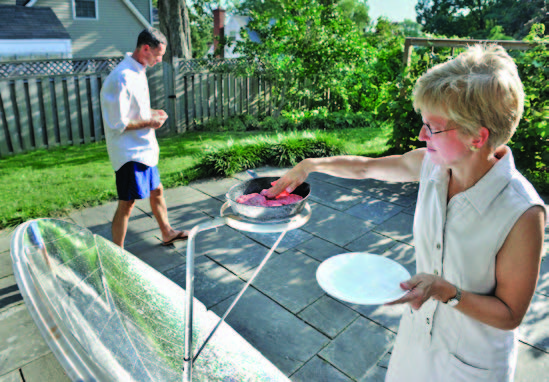In the classroom, Valerie Thomas, Anderson Interface Associate Professor of Natural Systems, and her students investigate energy and materials efficiency, sustainability measures, and industrial ecology. At home, she and her family apply sustainability science to everyday life by experimenting with a unique approach to cooking. If you were to visit Thomas for a weekend meal, you might find her in the backyard next to an odd cooking contraption, a stove that looks like something the Jetsons would have used. In fact, it’s a parabolic stove that uses the energy of the sun as fuel.
What motivated you to begin cooking on a parabolic stove?
I’ve been cooking with a solar oven for several years now. The solar oven works great, but I wanted to be able do stove-top type cooking, so I got a parabolic stove.
What kinds of things do you cook or not cook on it?
We boil water for tea and coffee. I cook hamburgers, sausages, eggs, and vegetables. Basically it’s exactly like a gas burner on a gas stove. However, mine is a bit harder to manage than my gas stove. Generally, I end up having the hot spot a bit more on one side rather than exactly in the middle. Also, it is a bit over-focused so to get even cooking I need to swivel the pan back and forth a little. I don’t use it for gentle, slow simmering.
One limitation is that the sun has to be up. Even in the summer, if I wanted to rely on it for morning tea, I would usually have to wait until 10 a.m. or so.
How often do you use the stove?
I only use it about one day a week, on the weekends, because most days I’m not there much before sundown. It would work in the winter, but I don’t use it then because it involves going in and out of the house a lot. I use it like other people use an outdoor grill. It’s a fun way to cook.\
How is cooking on this different/similar to cooking on a regular stove?
Since I’m relying on the sun, I really do have to strike while the iron is hot. Using a solar stove leads me more toward cooking food in the middle of the day, and being mindful of how late it is in the afternoon and how much sun is left.
Describe the process from set up to shut down for cooking one of your favorite recipes.
The first step is to get the stove into the sun and pointed at the right angle. That could involve picking it up and moving it to a sunny spot. Then I tilt the parabola back and forth until the heat is focused on the cooking ring. Once I get the angle to the sun about right, I wave my hand through to feel where the heat is to see if I need to make some adjustments to the angle. Next I put the pan on the cooking ring and look underneath to see exactly where the bright sunny spot is on the bottom of the pan. I continue to make small tilts and turns to get the bright spot to be in the middle of the pan. Then, I proceed as usual. Let’s say I’m making a stir fry. I’ll pour some oil in the pan, wait a bit, tilt the pan around to cover the bottom of the pan with oil, add some spices, stir a bit with a spatula, add some onions and garlic, add the other ingredients, stir around a bit more, and it’s done. To shut down, I just swivel the parabola a bit to the side.
This article first appeared in the Fall 2013 ISyE Alumni Magazine.
